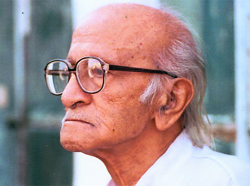The pace of life has changed drastically, creating all sorts of health problems. What cure does ayurveda have for lifestyle ailments such as obesity?
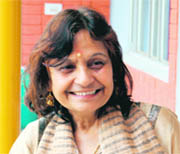 Dr Vinod Verma feels that ayurveda is the mother of all other medical systems |
Well, health problems are there because we have forgotten the age-old tradition of ayurveda, which is not merely a medical system but this enormous wisdom is for leading a healthy and happy life with total well-being of the body and the mind. Emphasis on achara-vyavahara (lifestyle) is the primary wisdom of ayurveda. One should live with desha and kala (space and time).
I have made a mantra in my book, Ayurvedic Food Culture and Recipes, for teaching the fundamentals of ayurvedic nutrition—eating what, when, how and how much. All these factors have to be learnt individually and should be co-related. The whole ayurvedic food culture or other aspects cannot be learnt in a day. Otherwise, there was no need for me to write so many books.
Bad food with chemical fertilisers, artificial colours and flavour, bad quality fats, too much salt and sugar are some of the causes of over-weight and obesity.
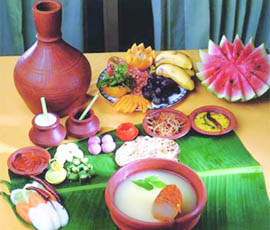 Each individual should learn about the fundamentals of ayurvedic lifestyle and make an effort to remain healthy |
Weight can vary due to constitution and structure of the body. One should take care of the shape and form of the body. There should be no extra hanging flesh. Let me give some suggestions for the benefit of your readers for balancing weight. Do surya pranam 12 times (it takes 10 minutes) after drinking a glass of hot water in the morning, or go for a half-an-hour walk. One should eat strictly three times a day, and absolutely nothing in between. Fill the stomach two-thirds, as ayurveda suggests. One-third of the stomach should be left for digestive juices. Never sit down after main meals. It is advised to walk at least 100 steps after the meal, or get involved in other activities that need body movements.
Eat your dinner at least two hours before going to bed, and lastly, drink a glass of hot water after getting up in the morning and before going to bed at night. Following these nutrition principles of ayurveda, not only will you be able to control your weight, but you will also get rid of minor stomach problems.
Does ayurveda have cure for psychological ailments like depression, stress, anxiety?
Ayurveda has cure for psychological and mental ailments. But the way your question is formulated, you have a mindset of modern medicine, which has a capsule-and-injection culture. In ayurveda, the treatment means a lot of other things besides aushadhi (medicine) — nutrition, external application of heat and other ointments, yogasanas and pranayama, japa for spiritual therapy, etc. If we compare the modern methods of therapy and ayurvedic treatment with food, the former is fast food, which gives rise ultimately to bad health, and the latter is a gourmet meal prepared with great effort and love, and has a rejuvenating effect on your body.
We live in a highly competitive world. As a result, there is a tremendous pressure on children to do well academically. Have you got any tips for sharpening the brain cells?
The stress and pressure are not only managed by sharpening the brain cells. One equally needs a good training in sattvic (pure) thoughts, which today's parents are not providing. For promoting memory, one should powder the following products and take a tablespoon of these with hot milk everyday: cashew nuts—5 parts; pepper—1 part; pippali—1 part; coriander—1 part; mullethi—1 part; saunf—1 part. There are many other products also in ayurveda but this is a simple home remedy people can make themselves.
You are involved in research. Tell us about it, and how it will help people in general.
My research involves gathering practical wisdom of ayurveda from all sources in the country and making it available to the common people for the benefit of health, promoting strength and preventing ailments. There exist so many simple solutions to complicated problems. To give you a simple example, I have cured many people of their nagging stomach problems by making them follow the eight principles of ayurvedic food culture.
All this is only possible with the personal efforts of each individual. Vaidyas and doctors are meant for emergencies and to treat ailments, and not for your headaches, cough and cold.
Each individual should learn about the fundamentals of ayurvedic lifestyle, make a conscious effort to remain healthy, enhance strength by taking rasayanas, make all efforts to prevent ailments, eat organic, well-prepared wholesome food with variety of herbs and spices, detoxify the body from time to time with some special products, do the inner and outer cleansing of the body, and make sure that the mala is excreted properly.
Is ayurveda scientific?
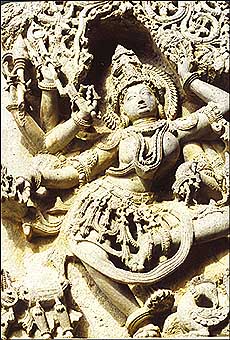

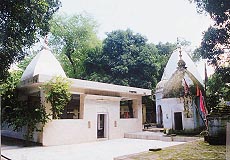
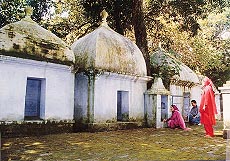

 After the war, Baba wanted to retire to the hills in order to pursue his spiritual goals. While he bathed in the cool waters of one of the valleys, he saw the images of the 10 Gurus. Thus he decided to name it the Darshani Khud and the waters of this khud came to be called Dhauli Dhar or Charanganga.
After the war, Baba wanted to retire to the hills in order to pursue his spiritual goals. While he bathed in the cool waters of one of the valleys, he saw the images of the 10 Gurus. Thus he decided to name it the Darshani Khud and the waters of this khud came to be called Dhauli Dhar or Charanganga.  As the farmers waited with bated breath, Shri Guru Gobind Singh ji, the Tenth Guru, appeared holding a naked sword in his hand. He raised his sword and demanded a head from one of his followers. A hush fell over the gathering. No one demurred. The Guru repeated his words. On hearing his demand for the third time, one Daya Ram of Lahore stepped forward and said: "My head is at your service, my Lord", The Guru took the disciple into a nearby tent and soon returned. His sword was now dripping with blood. He raised his authoritative voice and demanded yet another head. Far from being daunted by the thought of death, another disciple, Dharam Das of Delhi, volunteered to sacrifice himself for his Guru. In the events that followed Guru Gobind Singh made three more such calls and consequently Mohkam Chand of Dwarka, Himmat of Jagannath, and Sahib Chand of Bidar came forward and offered their heads.
As the farmers waited with bated breath, Shri Guru Gobind Singh ji, the Tenth Guru, appeared holding a naked sword in his hand. He raised his sword and demanded a head from one of his followers. A hush fell over the gathering. No one demurred. The Guru repeated his words. On hearing his demand for the third time, one Daya Ram of Lahore stepped forward and said: "My head is at your service, my Lord", The Guru took the disciple into a nearby tent and soon returned. His sword was now dripping with blood. He raised his authoritative voice and demanded yet another head. Far from being daunted by the thought of death, another disciple, Dharam Das of Delhi, volunteered to sacrifice himself for his Guru. In the events that followed Guru Gobind Singh made three more such calls and consequently Mohkam Chand of Dwarka, Himmat of Jagannath, and Sahib Chand of Bidar came forward and offered their heads.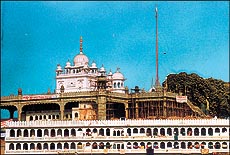 Earlier, it was a custom to drink the water with which the Gurus washed their feet, but as Guru Gobind Singh wanted to instil martial spirit in his followers, and thus change them from Sikhs to Singhs (lions), he proposed to baptise them by water stirred with a khanda (sword). To strike a blow against the class-ridden society, he urged all his followers to attach 'Singh' to their first names irrespective of their caste or creed. He also asked them to always have on their person Kesh, Kangha, Karha, Kaccha and Kirpan (long hair, a comb, a steel bracelet, a vest, and sword). His followers were to celebrate Holi by conducting martial arts, sport, military parades and mock battles. He later baptised about 20,000 disciples and named the place Shri Anandpur Sahib, the city of bliss.
Earlier, it was a custom to drink the water with which the Gurus washed their feet, but as Guru Gobind Singh wanted to instil martial spirit in his followers, and thus change them from Sikhs to Singhs (lions), he proposed to baptise them by water stirred with a khanda (sword). To strike a blow against the class-ridden society, he urged all his followers to attach 'Singh' to their first names irrespective of their caste or creed. He also asked them to always have on their person Kesh, Kangha, Karha, Kaccha and Kirpan (long hair, a comb, a steel bracelet, a vest, and sword). His followers were to celebrate Holi by conducting martial arts, sport, military parades and mock battles. He later baptised about 20,000 disciples and named the place Shri Anandpur Sahib, the city of bliss.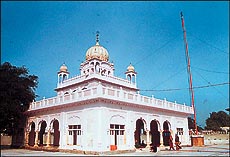 After the martyrdom of Guru Tegh Bahadur, Guru Gobind Singh began to plan his strategy at Gurdwara Fatehgarh Sahib. But before tackling the Mughal forces he had to reckon with Raja Bhim Chand of Bilaspur who had sent a force under Raja Kesari Chand to attack Anandpur Sahib. The Guru organised a battalion and ordered Bhai Uday Singh to get ready for battle. Bhai Uday Singh beheaded Kesari Chand and offered his head to the Guru. Guru Gobind Singh was very proud of his victorious army, so he built a fort at the spot and called it Fatehgarh Sahib.
After the martyrdom of Guru Tegh Bahadur, Guru Gobind Singh began to plan his strategy at Gurdwara Fatehgarh Sahib. But before tackling the Mughal forces he had to reckon with Raja Bhim Chand of Bilaspur who had sent a force under Raja Kesari Chand to attack Anandpur Sahib. The Guru organised a battalion and ordered Bhai Uday Singh to get ready for battle. Bhai Uday Singh beheaded Kesari Chand and offered his head to the Guru. Guru Gobind Singh was very proud of his victorious army, so he built a fort at the spot and called it Fatehgarh Sahib.

